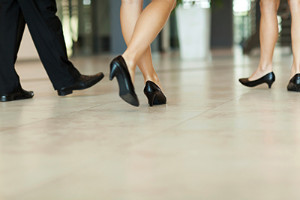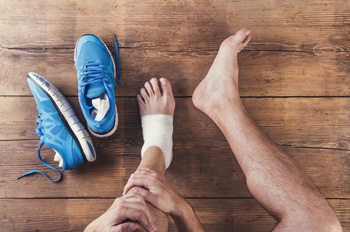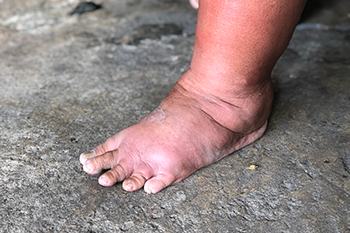
The ankle joint is a complex combination of bones, muscles, ligaments, tendons, and nerves. For that reason, there are many causes of ankle pain. The most common is a sprain, which happens when a ligament is stretched beyond its normal range and tears or ruptures. Another cause of ankle pain is stress fractures, which are hairline cracks in the bones that are caused by the type of repetitive pounding that occurs while running or playing sports. Other causes of ankle pain include arthritis, gout, and Achilles tendonitis. Gout is an inflammatory condition related to the overabundance of uric acid in the body. Crystals can form within the ankle joint and cause extreme pain. Achilles tendonitis is largely the result of overuse in the tendon that attaches the calf muscles to the heel. Resting the ankle is the first on the treatment list, but if bearing weight on the injured foot is difficult or impossible, it is suggested that you consult a chiropodist for help.
Ankle pain is a common symptom of many lower limb problems. If you are experiencing ankle pain, please consult with one of the chiropodists from The Footcare Centre. Our chiropodists will assess your condition and provide you with quality foot and ankle treatment.
The ankle is composed of a number of muscles, bones, tendons, and ligaments. There are many conditions which may cause ankle pain.
Causes
Ankle strains or sprains
Achilles tendon injuries
Fractures
Bursitis
Arthritis
Gout
Tarsal tunnel syndrome
Symptoms
If you have ankle pain, you may also experience a variety of other symptoms depending on the underlying cause of the pain. Some of these symptoms may include ankle swelling, bruising, redness, numbness or tingling, instability, and difficulty walking.
Diagnosis
The underlying cause of ankle pain can be diagnosed by a chiropodist. Diagnoses are typically made based on your medical history, a physical examination of the affected ankle, and imaging studies such as X-rays.
Treatment
Treatment for your ankle pain will depend on its underlying cause. Often, the chiropodist will recommend that you rest the affected ankle. You might also need to ice, compress, and elevate the ankle, wear an orthotic device, or take medications to reduce pain and inflammation.
If you have any questions, please feel free to contact our office located in . We offer the newest diagnostic and treatment technologies for all your foot care needs.









